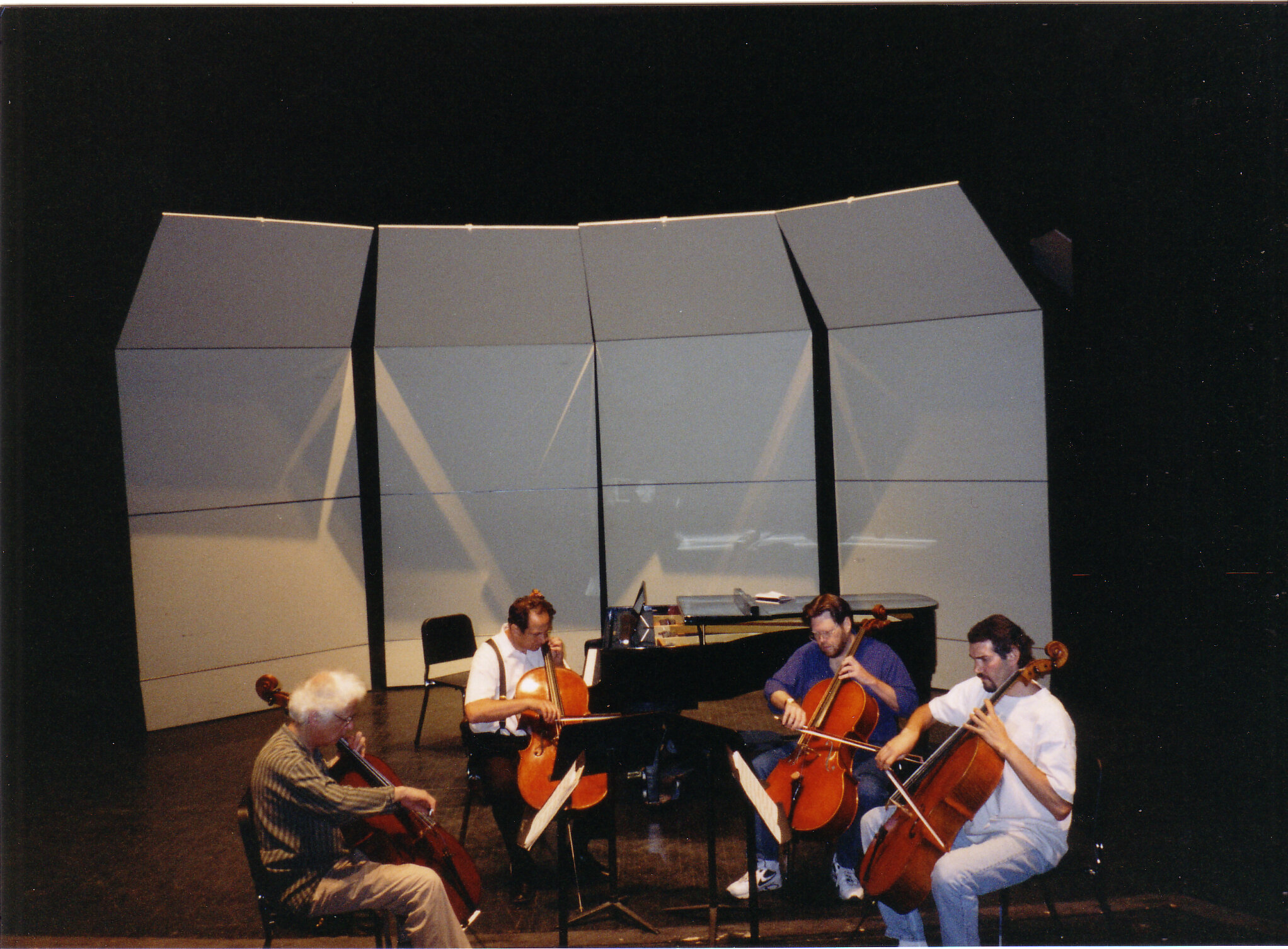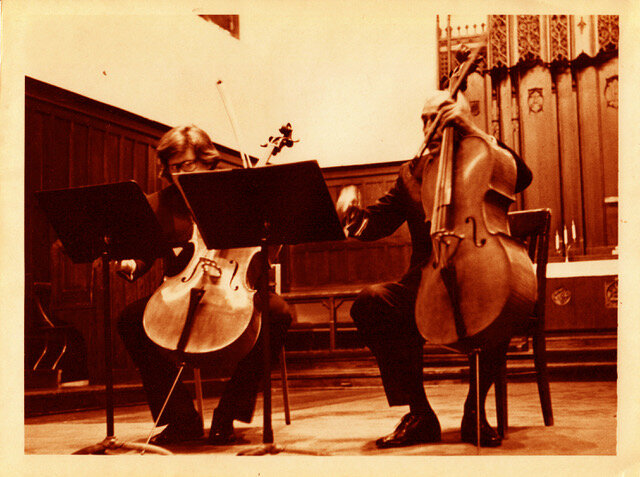
Laurence Lesser, Stephen Kates, and Evan Drachman
Why Make Arrangements?
While with the Mirecourt Trio we learned to “know thy audience” in our twenty years together. We wanted to greet them with familiarity rather than confrontation of the unknown, as well as present the great works. After all, they came in good faith. Most of our bread and butter touring was in the Midwest on Community Concerts and other series. Often we were the only classical group. Those that bought season tickets may have never gone to a classical concert, and we wanted to create fans.
Presenting programs with the standard food groups—Classical, Romantic and Modern—was fine for college towns and larger venues, but other locales needed the ice broken. The trio repertoire is full of monuments, and with them multi-movement segments that might overwhelm the novice. The repertoire lacked short pieces, stand-alone pieces incapsulating sentiments and direct effects. We were not interested in breaking up the great works.
Our pianist, the hugely talented John Jensen, was expert at jazz and improvisation in addition to his mainstream artistry. It fell to him to bring popular styles to chamber music. He was masterful at creating medleys of familiar music--ragtime, popular song and jazz with composers like Ellington--into concert pieces worthy of any concert hall. In this regard, I wanted to bridge classical “pops” into the realm. The bug bit me.
I chose pieces that drew me into music in the first place. As a kid glued to after school television, cartoons were always shown. “Back in my day” they broadcasted the old black and whites along with the wonderful Warner Bros. masterpieces. Quite often classical works were played instead of continuous dialog and sound-effects, excerpted of course to fit the action. But, the music survived the visual even if it was not presented in a standard symphonic setting; those renditions were mostly done with small band ensembles. What did I know? I never heard a symphony orchestra.
Once in elementary school our teacher played a recording before class began. It was the overture to William Tell; I recognized it as cartoon music, but it sounded fantastic and gripped me to my core. I was transfixed and wept when it stopped. And there it sat. I had no way of knowing anything about how to hear more or what it was. I did have the nerve to ask the teacher during recess, but all she did was laugh; I was still tearing up. Seems impossible now, but sometimes authorities can let you down without knowing the damage they cause. Eventually I put the pieces together.
So, light classics became my goal and it seemed to work. We found that lighter and shorter fare, especially at the beginning of a concert (hence “overture”), did the trick of ingratiating the audience priming them for one of the great works in the second half. We also played these pieces in summer series. The virtuosity they require is also impressive. It’s curious, but when you look at recital programs from the early 20thC, lighter fare was more prevalent on the second half of the program.
Arrangements available for purchase upon request
Cello and String Orchestra
Bloch: Prayer (from Jewish Pieces) (pub. Ovation Press). Faure: Sicilienne (from Pelleas et Melisande) (with harp) (pub. Ovation Press). Lalo: Chants russe (from Concerto russe, op.29) Massenet: Meditation (from Thaiis) (with harp). Saint-Saens: Andantino (from Violin Concerto no.3)
Cello, Piano
Albeniz-Bolognini: Malaguena Beethoven: Sonata movement in Eb, op. 3 (reconstruction from MS). Beethoven: 12 Variations Se vous ballare WoO40 Beethoven: Rondo in G, WoO41 Beethoven: Six German Dances, WoO42 Boulanger, Georges: Comme ci comme ca/Da Capo/Prayer Gershwin: Three Preludes Grieg: Intermezzo and Humoreske (from Violin Sonata no.2) Sarasate: Zapateado Schubert: Arpeggione (simplified) Smyth: Sonata in c
Two Cellos and Piano
Grieg: Sarabande and Rigaudon (from Holberg Suite) Prokofiev: Regrets and Tag (Music for Children) Sibelius: Solitude (Belshazzar's Feast) [piano/harp] Sibelius: Musette (King Christian II Suite, Op.27/2) Sibelius: Melisande (Pelleas and Melisande, Op.46/2)
Piano Trio
Anderson: Fiddle-Faddle Brahms: Hungarian Dance no.1 Brahms: Hungarian Dance no.7 Copland: Hoe Down (from Rodeo) de Falla: Farucca (from Three-Cornered Hat) Dvorak: Slavonic Dance op.47 no.7 Enescu: Romanian Rhapsody op.11 no.1 Faure: Sicilienne (from Pelleas et Melisande) Gershwin: 3 Preludes Glinka: Ruslan and Ludmila Monti: Csardas Mozart: Sonata in D, K.7 Rimsky-Korsakov: Flight of the Bumble-Bee Sousa: The Stars and Stripes Forever/The Thunderer Suppe: Poet and Peasant
Piano Quartet
Anderson: Jazz Pizzicato Carmichael: Stardust Dvorak: Slavonic Dance, op.46 no.3 Dvorak: Slavonic Dance, op.72 no.7 Kreisler: Caprice viennoise
String Quartet
Albeniz: Cordoba (from Chants d’Espagne, op.232 no.4) Albeniz: En la Playa [On the Beach] (from Recuerdos de viaje, op. 71 no.7) Albeniz: Seguidillas (Suite Espagnole) Albeniz: Sous le Palmier [Under the Palm Tree] from Chants d’Espagne, op.232 no.3 de Falla: Farucca (from Three-Cornered Hat) Fernandez: Ceilito Lindo Granados: Intermezzo (from Goyescas) Kaempfert: Spanish Eyes
Violin, Viola, Cello
Glinka: Doubt Schifrin: Mission Impossible
Violin and Cello
Albeniz: Tango , Mallorca Arbos: Seguidillas gitanas de Falla: Farucca (from Three-Cornered Hat) Granados: Intermezzo (from Goyescas) Mancini: The Pink Panther (also for violin and viola) Schifrin: Mission Impossible Villa-Lobos: Alnitah (from The Three Maries)
2 Cellos
Mozart: Sonata in C, K.292 Nero, Peter: Pitzi-Cats Prokofiev: Promenade, Fairy-Tale, Tarantelle (from Music for Children, op.65) Satie: Gnossienne no.4
3 Cellos
Beethoven: Variations on La Ci Darem La Mano (Mozart) Dvorak Drobnosti (Minatures) op. 75a [Cavatina, Capriccio, Romanza, Gavota] Mozart: Serenade (Viennese Sonatinas) Shostakovich: Valse Badinere (Ballet Suite no.1)
Cello Quartet (or cello orchestra)
Albeniz: Cordoba (from Chants d’Espagne, op.232 no.4) Albeniz: En la Playa [On the Beach] (from Recuerdos de viaje, op. 71 no.7) Albeniz: Sous le Palmier [Under the Palm Tree] from Chants d’Espagne, op.232 no.3 Anderson: Jazz Pizzicato Debussy: Menuet (from Petite Suite) Dvorak from Drobnosti (Miniatures) op.75a: Elegia Gershwin: Three Preludes Grieg: Cow Keeper’s Tune and Country Dance Liadov: Plaintive Song Russian Folksongs, op.58) Nero, Peter: Fantasy Prokofiev: Scherzo Humorestique, op.12 no.9 Schifrin: Mission Impossible Sibelius: Musette (from King Christian) Sousa: The Thunderer Stravinsky: Vivo (from Pulcinella) Vivaldi: Concerto in C, RV88 Vivaldi: Concerto in F, RV100 Vivaldi: Sonata á4 in Eb, RV130 "Al Santo Sepolcro"
Cello Ensemble
Grieg: Elegiac Melodies (Heart’s Wound, Last Spring) Vivaldi: Concerto in C, RV507 for 2 solo cellos and cello ensemble Vivaldi: Concerto in D, RV511 for 2 solo cellos and cello ensemble Vivaldi: Concerto in D, RV564 for 4 solo cellos and cello ensemble Vivaldi: Concerto in G, RV575 for 4 solo cellos and cello ensemble
Piatigorsky editions
Bach, J.S: Adagio BWV 1024 [attrib. Pisendel]
Boccherini-Piatigorsky: Sonata in C
Chopin-Piatigorsky: Introduction and Polonaise Brilante, op.3 Ovation Press
Debussy-Piatigorsky: Prelude/Intermezzo
Faure-Piatigorsky: Tarantelle, op.10/2
Paganini-Piatigorsky: Divertimento (Divertissement)
Paganini-Piatigorsky: La Campanella (La Clochette)
Piatigorsky: Four Pieces for Solo Cello: Prelude, Prayer, Syrinx, Stroll
Piatigorsky: cadenzas to concertos by Boccherini in G, Haydn in D, Herbert no.2,
Schumann, Volkmann, and Vivaldi Concerto for Two Cellos
Prokofiev-Piatigorsky: Masques from Romeo and Juliet, op. 64
Prokofiev-Piatigorsky: Regrets from Music for Children
Scriabin-Piatigorsky: Romance
Stravinsky-Piatigorsky: Suite Italienne arr. for violin and cello and for 4 cellos Boosey & Hawkes
Szymanowski-Piatigorsky: Etude op.4/3
